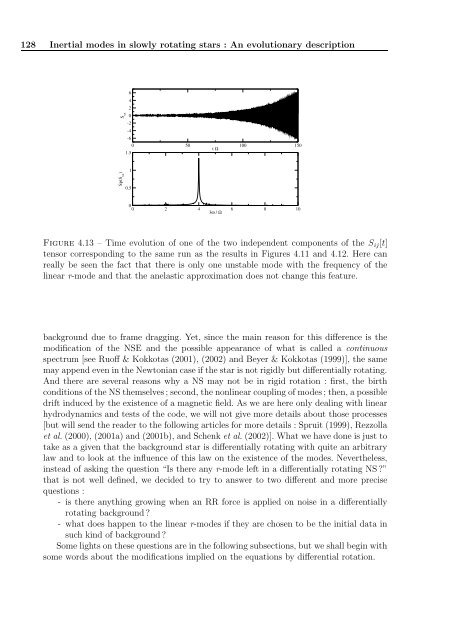Ecole doctorale de Physique de la région Parisienne (ED107)
Ecole doctorale de Physique de la région Parisienne (ED107)
Ecole doctorale de Physique de la région Parisienne (ED107)
You also want an ePaper? Increase the reach of your titles
YUMPU automatically turns print PDFs into web optimized ePapers that Google loves.
128 Inertial mo<strong>de</strong>s in slowly rotating stars : An evolutionary <strong>de</strong>scription<br />
S xx<br />
Sp(S xx )<br />
6<br />
4<br />
2<br />
0<br />
-2<br />
-4<br />
-6<br />
0 50 100 150<br />
t Ω<br />
1.5<br />
1<br />
0.5<br />
0<br />
0 2 4 6 8 10<br />
3ω / Ω<br />
Figure 4.13 – Time evolution of one of the two in<strong>de</strong>pen<strong>de</strong>nt components of the Sij[t]<br />
tensor corresponding to the same run as the results in Figures 4.11 and 4.12. Here can<br />
really be seen the fact that there is only one unstable mo<strong>de</strong> with the frequency of the<br />
linear r-mo<strong>de</strong> and that the ane<strong>la</strong>stic approximation does not change this feature.<br />
background due to frame dragging. Yet, since the main reason for this difference is the<br />
modification of the NSE and the possible appearance of what is called a continuous<br />
spectrum [see Ruoff & Kokkotas (2001), (2002) and Beyer & Kokkotas (1999)], the same<br />
may append even in the Newtonian case if the star is not rigidly but differentially rotating.<br />
And there are several reasons why a NS may not be in rigid rotation : first, the birth<br />
conditions of the NS themselves ; second, the nonlinear coupling of mo<strong>de</strong>s ; then, a possible<br />
drift induced by the existence of a magnetic field. As we are here only <strong>de</strong>aling with linear<br />
hydrodynamics and tests of the co<strong>de</strong>, we will not give more <strong>de</strong>tails about those processes<br />
[but will send the rea<strong>de</strong>r to the following articles for more <strong>de</strong>tails : Spruit (1999), Rezzol<strong>la</strong><br />
et al. (2000), (2001a) and (2001b), and Schenk et al. (2002)]. What we have done is just to<br />
take as a given that the background star is differentially rotating with quite an arbitrary<br />
<strong>la</strong>w and to look at the influence of this <strong>la</strong>w on the existence of the mo<strong>de</strong>s. Nevertheless,<br />
instead of asking the question “Is there any r-mo<strong>de</strong> left in a differentially rotating NS ?”<br />
that is not well <strong>de</strong>fined, we <strong>de</strong>ci<strong>de</strong>d to try to answer to two different and more precise<br />
questions :<br />
- is there anything growing when an RR force is applied on noise in a differentially<br />
rotating background ?<br />
- what does happen to the linear r-mo<strong>de</strong>s if they are chosen to be the initial data in<br />
such kind of background ?<br />
Some lights on these questions are in the following subsections, but we shall begin with<br />
some words about the modifications implied on the equations by differential rotation.
















